11.1: Introduction
- Page ID
- 189675
\( \newcommand{\vecs}[1]{\overset { \scriptstyle \rightharpoonup} {\mathbf{#1}} } \)
\( \newcommand{\vecd}[1]{\overset{-\!-\!\rightharpoonup}{\vphantom{a}\smash {#1}}} \)
\( \newcommand{\id}{\mathrm{id}}\) \( \newcommand{\Span}{\mathrm{span}}\)
( \newcommand{\kernel}{\mathrm{null}\,}\) \( \newcommand{\range}{\mathrm{range}\,}\)
\( \newcommand{\RealPart}{\mathrm{Re}}\) \( \newcommand{\ImaginaryPart}{\mathrm{Im}}\)
\( \newcommand{\Argument}{\mathrm{Arg}}\) \( \newcommand{\norm}[1]{\| #1 \|}\)
\( \newcommand{\inner}[2]{\langle #1, #2 \rangle}\)
\( \newcommand{\Span}{\mathrm{span}}\)
\( \newcommand{\id}{\mathrm{id}}\)
\( \newcommand{\Span}{\mathrm{span}}\)
\( \newcommand{\kernel}{\mathrm{null}\,}\)
\( \newcommand{\range}{\mathrm{range}\,}\)
\( \newcommand{\RealPart}{\mathrm{Re}}\)
\( \newcommand{\ImaginaryPart}{\mathrm{Im}}\)
\( \newcommand{\Argument}{\mathrm{Arg}}\)
\( \newcommand{\norm}[1]{\| #1 \|}\)
\( \newcommand{\inner}[2]{\langle #1, #2 \rangle}\)
\( \newcommand{\Span}{\mathrm{span}}\) \( \newcommand{\AA}{\unicode[.8,0]{x212B}}\)
\( \newcommand{\vectorA}[1]{\vec{#1}} % arrow\)
\( \newcommand{\vectorAt}[1]{\vec{\text{#1}}} % arrow\)
\( \newcommand{\vectorB}[1]{\overset { \scriptstyle \rightharpoonup} {\mathbf{#1}} } \)
\( \newcommand{\vectorC}[1]{\textbf{#1}} \)
\( \newcommand{\vectorD}[1]{\overrightarrow{#1}} \)
\( \newcommand{\vectorDt}[1]{\overrightarrow{\text{#1}}} \)
\( \newcommand{\vectE}[1]{\overset{-\!-\!\rightharpoonup}{\vphantom{a}\smash{\mathbf {#1}}}} \)
\( \newcommand{\vecs}[1]{\overset { \scriptstyle \rightharpoonup} {\mathbf{#1}} } \)
\( \newcommand{\vecd}[1]{\overset{-\!-\!\rightharpoonup}{\vphantom{a}\smash {#1}}} \)
\(\newcommand{\avec}{\mathbf a}\) \(\newcommand{\bvec}{\mathbf b}\) \(\newcommand{\cvec}{\mathbf c}\) \(\newcommand{\dvec}{\mathbf d}\) \(\newcommand{\dtil}{\widetilde{\mathbf d}}\) \(\newcommand{\evec}{\mathbf e}\) \(\newcommand{\fvec}{\mathbf f}\) \(\newcommand{\nvec}{\mathbf n}\) \(\newcommand{\pvec}{\mathbf p}\) \(\newcommand{\qvec}{\mathbf q}\) \(\newcommand{\svec}{\mathbf s}\) \(\newcommand{\tvec}{\mathbf t}\) \(\newcommand{\uvec}{\mathbf u}\) \(\newcommand{\vvec}{\mathbf v}\) \(\newcommand{\wvec}{\mathbf w}\) \(\newcommand{\xvec}{\mathbf x}\) \(\newcommand{\yvec}{\mathbf y}\) \(\newcommand{\zvec}{\mathbf z}\) \(\newcommand{\rvec}{\mathbf r}\) \(\newcommand{\mvec}{\mathbf m}\) \(\newcommand{\zerovec}{\mathbf 0}\) \(\newcommand{\onevec}{\mathbf 1}\) \(\newcommand{\real}{\mathbb R}\) \(\newcommand{\twovec}[2]{\left[\begin{array}{r}#1 \\ #2 \end{array}\right]}\) \(\newcommand{\ctwovec}[2]{\left[\begin{array}{c}#1 \\ #2 \end{array}\right]}\) \(\newcommand{\threevec}[3]{\left[\begin{array}{r}#1 \\ #2 \\ #3 \end{array}\right]}\) \(\newcommand{\cthreevec}[3]{\left[\begin{array}{c}#1 \\ #2 \\ #3 \end{array}\right]}\) \(\newcommand{\fourvec}[4]{\left[\begin{array}{r}#1 \\ #2 \\ #3 \\ #4 \end{array}\right]}\) \(\newcommand{\cfourvec}[4]{\left[\begin{array}{c}#1 \\ #2 \\ #3 \\ #4 \end{array}\right]}\) \(\newcommand{\fivevec}[5]{\left[\begin{array}{r}#1 \\ #2 \\ #3 \\ #4 \\ #5 \\ \end{array}\right]}\) \(\newcommand{\cfivevec}[5]{\left[\begin{array}{c}#1 \\ #2 \\ #3 \\ #4 \\ #5 \\ \end{array}\right]}\) \(\newcommand{\mattwo}[4]{\left[\begin{array}{rr}#1 \amp #2 \\ #3 \amp #4 \\ \end{array}\right]}\) \(\newcommand{\laspan}[1]{\text{Span}\{#1\}}\) \(\newcommand{\bcal}{\cal B}\) \(\newcommand{\ccal}{\cal C}\) \(\newcommand{\scal}{\cal S}\) \(\newcommand{\wcal}{\cal W}\) \(\newcommand{\ecal}{\cal E}\) \(\newcommand{\coords}[2]{\left\{#1\right\}_{#2}}\) \(\newcommand{\gray}[1]{\color{gray}{#1}}\) \(\newcommand{\lgray}[1]{\color{lightgray}{#1}}\) \(\newcommand{\rank}{\operatorname{rank}}\) \(\newcommand{\row}{\text{Row}}\) \(\newcommand{\col}{\text{Col}}\) \(\renewcommand{\row}{\text{Row}}\) \(\newcommand{\nul}{\text{Nul}}\) \(\newcommand{\var}{\text{Var}}\) \(\newcommand{\corr}{\text{corr}}\) \(\newcommand{\len}[1]{\left|#1\right|}\) \(\newcommand{\bbar}{\overline{\bvec}}\) \(\newcommand{\bhat}{\widehat{\bvec}}\) \(\newcommand{\bperp}{\bvec^\perp}\) \(\newcommand{\xhat}{\widehat{\xvec}}\) \(\newcommand{\vhat}{\widehat{\vvec}}\) \(\newcommand{\uhat}{\widehat{\uvec}}\) \(\newcommand{\what}{\widehat{\wvec}}\) \(\newcommand{\Sighat}{\widehat{\Sigma}}\) \(\newcommand{\lt}{<}\) \(\newcommand{\gt}{>}\) \(\newcommand{\amp}{&}\) \(\definecolor{fillinmathshade}{gray}{0.9}\)Transition metals are found in the middle of the periodic table. In addition to being found in the metallic state, they also form a range of compounds with different properties. Many of these compounds are ionic or network solids, but there are also some molecular compounds, in which different atoms are arranged around a metal ion. These compounds are called transition metal complexes or coordination complexes. They are often brightly-colored compounds and they sometimes play very useful roles as catalysts or even as pharmaceuticals.
Because of their relatively low electronegativity, transition metals are frequently found as positively-charged ions, or cations. These metal ions are not found by themselves, instead, they attract other ions or molecules to themselves. These species bind to the metal ions, forming coordination complexes.
Hexaamminecobalt(III) chloride, [Co(NH3)6]Cl3, is an example of a coordination complex. It is a yellow compound. The "complex" part refers to the fact that the compound has a bunch of different pieces. There is a cationic part, which itself is a moderately complicated structure, plus three chloride anions.

Potassium hexachloroplatinate, K2[PtCl6], is another good example. It is another bright yellow compound. This time, the anion is the more complex part, and there are two potassium ions as well.
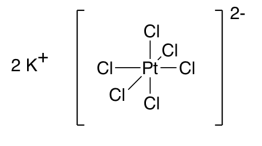
The formulae for coordination complexes always give you hints about the structures. The stuff inside the square brackets always makes up one of the ions. In that part, there are a number of things attached to the transition metal. Those things attached to the transition metal are called ligands; we'll take a closer look at them later. The part outside the square brackets tells you what the counterions are; those are there to balance out the charge of the ion inside the square brackets.
Very often, the counterions are individual atomic ions, like chloride anions (Cl-) or potassium cations (K+). So, when you see the K2 within the formula, the potassium atoms are not connected together; they are two separate potassium ions: 2 K+. Likewise, the Cl3 at the end of a formula does not really mean a group of three chlorine atoms clustered together; they are three separate chloride ions, 3 x Cl-.
Sometimes, polyatomic ions that act as counterions to these complexes; this is especially common in the case of anions. Most often, they are oxoanions, in which an atom has some number of oxygens attached to it. A couple of the most common examples are nitrate (NO3-) and sulfate (SO42-); these ions have been known for hundreds of years. Tetrafluoroborate (BF4-) and hexafluorophosphate (PF6-) are a couple of twentieth-century anions.
A number of common ions are listed in the table below. Most of them have a +1 or -1 charge. Sulfate is the only common example listed with a 2- charge.
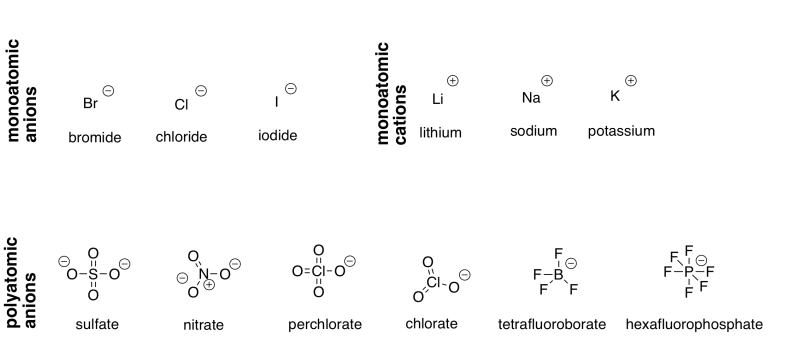
Note that some of these structures use a charge-minimised Lewis structure. In third-row elements, these structures may contain additional bonds to the central atom, going past the octet, in order to lower the number of + and - charges. Sulfate and perchlorate can also be drawn as octet-obedient structures, in which the sulfur and chlorine have true octets, and charge separation occurs. However, hexafluorophosphate has no octet-obedient Lewis structure; regardless of how you draw it, the phosphorus has six bonds.
Exercise \(\PageIndex{1}\)
Draw the octet-obedient structures for (a) sulfate and (b) perchlorate.
- Answer a
-

- Answer b
-

Exercise \(\PageIndex{2}\)
Indicate the individual ions in the following complexes.
- [Co(NH3)4Cl2]Cl
- [Co(NH3)5Cl]Cl2
- [Co(NH3)5NO2]Cl2
- [Co(NH3)5OH2]Cl3
- K2[PtCl4]
- Na2[Co(SCN)4]
- [Pt(NH3)2(OH2)2](NO3)2
- [Co(NH3)4(OH2)2]2(SO4)3
- Answer a
-
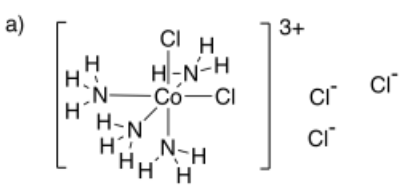
- Answer b
-
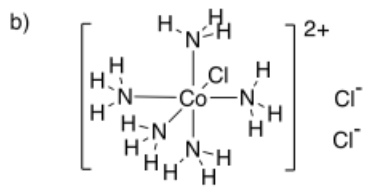
- Answer c
-
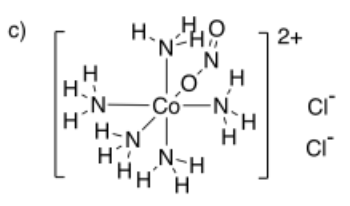
- Answer d
-
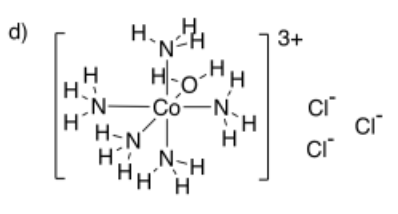
- Answer e
-

- Answer f
-
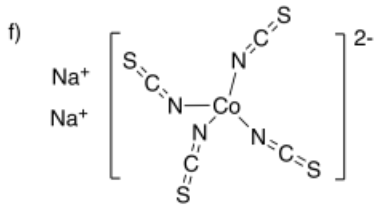
- Answer g
-

- Answer h
-

We haven't drawn proper Lewis structures for these coordination complexes so far. For the hexachloroplatinate complex, the Lewis structure is shown below:

The electron accounting looks like this:
| atom | electrons |
| Pt | 10 e- |
| Cl | 6 x 7 e- |
| charge | add 2 e- |
| total | 54 e- |
Two electrons for each bond takes up 12 electrons. That leaves 42 more. If each chlorine gets three lone pairs, that uses up another 36 electrons. There are six left, and they could be left on the platinum.
That is a lot of electrons. But remember where platinum sits in the periodic table: it's a transition metal. How many electrons does the next noble gas have? Eighteen: that's radon. This structure works out perfectly in terms of reaching a noble gas configuration.
For another example, let's take a look at the cobalt complex.

This time, the electron counting looks like:
| atom | electrons |
| Co | 9 e- |
| N | 6 x 5 e- |
| H | 18 x 1 e- |
| charge | lose 3 e- |
| total | 54 e- |
A dozen of those electrons get used for the six Co-N bonds, leaving 42 more. We need another 36 for the eighteen N-H bonds; that leaves six electrons. We can just put those on the cobalt, like last time.
Each nitrogen ends up with its octet (eight electrons in four bonds). Each hydrogen has its "octet" (two electrons in a bond, corresponding to helium's noble gas configuration. Cobalt also gets its "octet" (eighteen electrons corresponding to krypton's noble gas configuration).
These are still really big, unwieldy numbers. We need a simplification. We won't really count up all of the electrons in coordination complexes because they tend to be assembled from pre-existing parts (the "ligands") that already have their octets. The ligands are just donating their electrons to the metal in the center. Instead, we focus on that metal, and see how many electrons it has once all of the ligands have been attached.
Also, notice that in the Lewis structure of the cobalt complex, we neglected the formal charges. That's actually common practice with transition metal complexes. The reason for that is simply that the structure is getting pretty crowded with all the lone pairs and formal charges. Normally, in order to simplify an already complicated structure, the lone pairs on the transition metal and the formal charges are not shown.

On the next page, we will practice electron counting some more. We will also take a look at some common ligands: the pieces that are directly attached to the transition metal ions.
See a more in-depth discussion of coordination complexes in a later course.


